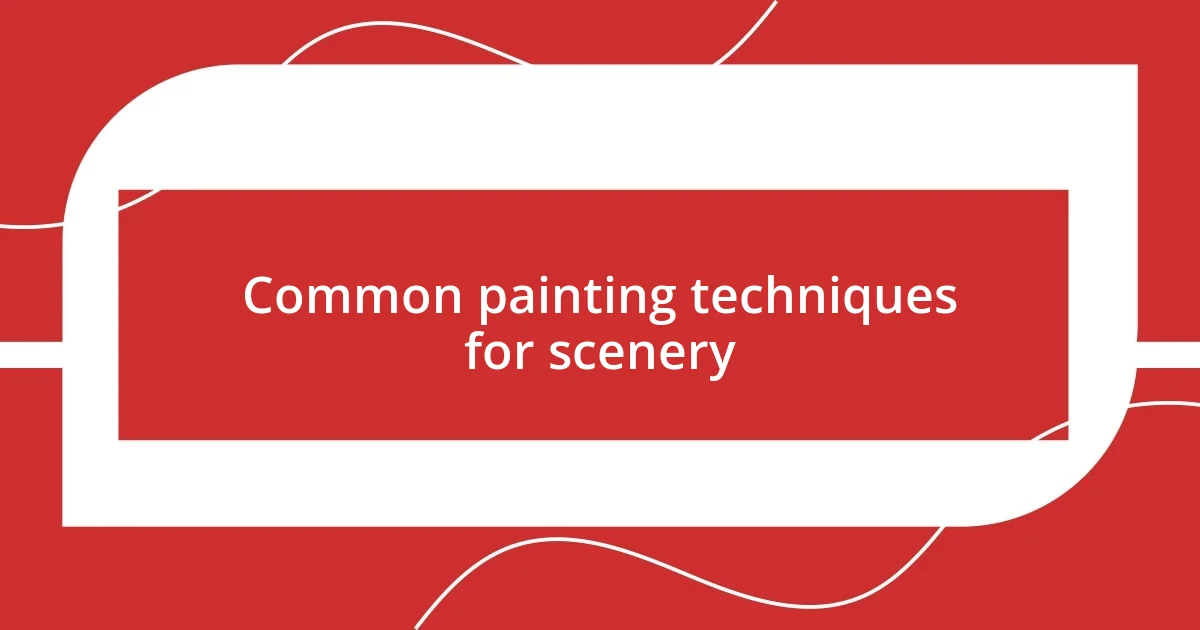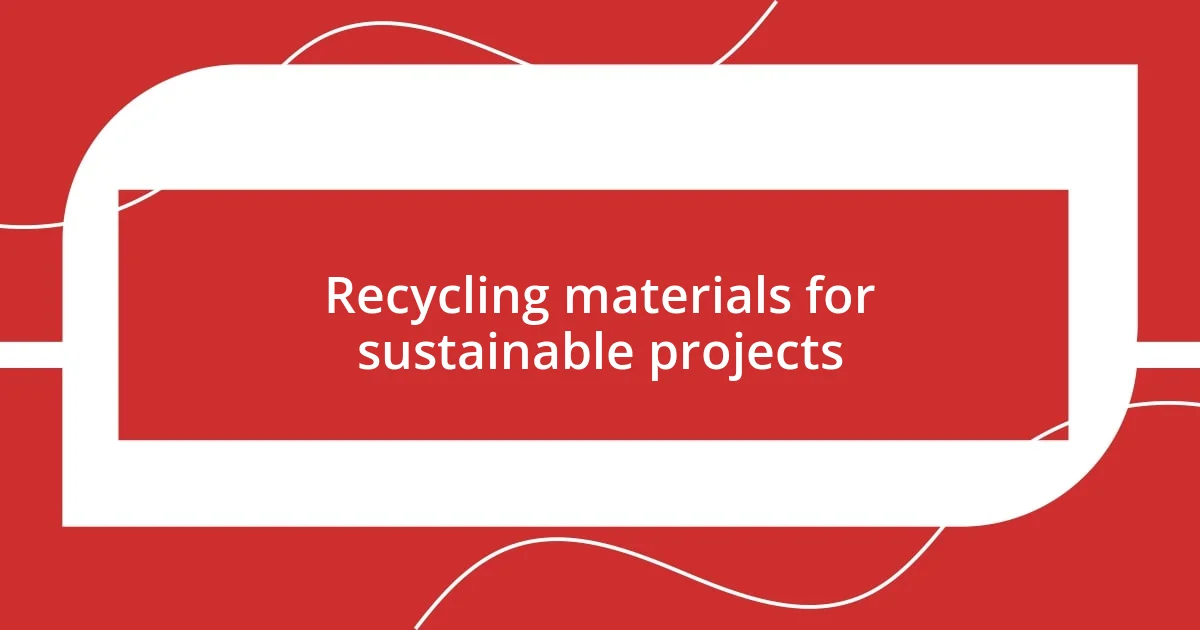Key takeaways:
- The choice of materials in stagecraft, such as types of wood and fabrics, significantly impacts the visual appeal and emotional tone of a production.
- Having essential tools, like utility knives and hot glue guns, facilitates creativity and efficiency in transforming ideas into tangible stage elements.
- Recycling materials not only promotes sustainability but also adds uniqueness and character to stage designs, allowing for innovative repurposing of everyday items.

Overview of stagecraft materials
When I think about stagecraft materials, my mind fills with a colorful palette of possibilities. From durable woods to lightweight fabrics, each material plays a unique role in bringing a production to life. Have you ever considered how the choice between canvas and muslin can completely alter a backdrop’s appearance? That decision can set the entire tone of a scene.
I remember a time when we needed to create a stunning forest backdrop for a school play. We decided to use a blend of cardboard and paint, which was both budget-friendly and effective. The excitement of watching the transformation from a plain stage to a vibrant woodland scenery was truly rewarding. It’s amazing how the right materials can evoke emotions and transport the audience into a different world.
Metals like aluminum and steel are also invaluable, especially for structural support in set designs. Their strength allows for bold and dynamic structures that can defy gravity, literally creating the illusion of magic on stage. Have you ever looked at an intricate set and wondered how it holds together? That curiosity often leads to a deeper appreciation for the craftsmanship involved in choosing the right materials for stagecraft.

Essential tools for stagecraft
Having the right tools is crucial for any stagecraft project. I vividly recall my early days, where a missing tool would turn a simple task into a frustrating ordeal. A well-stocked toolkit not only expedites the process but also sparks creativity. You’ll find that having the essential tools handy allows for spontaneous adjustments, which is often where the best ideas emerge.
Here’s a list of indispensable tools for stagecraft:
- Utility Knife: Ideal for cutting various materials, from fabrics to foam.
- Scissors: A must-have for precise cuts on softer materials.
- Tape Measure: Ensures that every element is perfectly sized and positioned.
- Level: Guarantees that your set pieces are straight and visually appealing.
- Hot Glue Gun: Perfect for quick fixes and secure attachments for various materials.
- Saw: Essential for crafting wood elements, offering more versatility than you might think.
- Paintbrushes: From tiny details to broad strokes, a variety of sizes can enhance your designs.
- Hammer and Nails: Basic yet crucial for assembling structural components.
Having fully equipped your toolkit, the stage becomes a playground for your imagination. It’s fascinating to see how the right tools can morph an idea into a tangible reality. I remember once, during a tight rehearsal schedule, how a precise cut with my utility knife made all the difference, allowing the set to fit perfectly in the space we had. Such moments remind me that sometimes, it’s the smallest tools that have the biggest impact on realizing our grand designs.

Types of wood for projects
When it comes to wood for stagecraft projects, the type you choose can significantly impact the outcome. Plywood, for instance, is a favorite of mine due to its versatility. It can be cut to create anything from set pieces to platforms. One time, I used plywood to build a makeshift stage for a talent show, and I was amazed at how sturdy and reliable it turned out. Who knew that a few layers of wood could provide such solid support for the performers?
I also find that using hardwoods like maple or oak adds a touch of elegance to more permanent set pieces. These woods are not only durable but also have an attractive grain that can enhance visual appeal. I remember creating a rustic dining table scene for a play, and the impressive grain patterns in the oak really caught the audience’s eye, adding to the overall authenticity of the set. It’s fascinating how the materials we work with can enhance storytelling, don’t you think?
On the other hand, softwoods like pine are great for budget-friendly projects. They’re lightweight and easy to manipulate, making them perfect for temporary backdrops and props. I once made an entire forest scene out of pine boards, which allowed for quick set changes while still looking fantastic under stage lights. Choosing the right kind of wood not only fits the project but also brings your creative vision to life!
| Type of Wood | Characteristics |
|---|---|
| Plywood | Versatile, sturdy, easy to cut; great for flat surfaces and structural components. |
| Hardwood (Maple, Oak) | Durable, attractive grain; excellent for permanent set pieces that require a polished look. |
| Softwood (Pine) | Lightweight, budget-friendly; ideal for temporary props and quick changes. |

Fabrics that enhance stage design
When it comes to fabrics that enhance stage design, the choice can truly transform a scene. I often gravitate toward velvets for their rich texture and depth. There was one unforgettable production where we draped a crimson velvet backdrop; the way it absorbed light and gave a luxurious feel to the set was simply breathtaking. Who knew that a piece of fabric could elevate the whole atmosphere?
Then there’s muslin, which holds a special place in my heart. I recall a time we used it to create ethereal sheer curtains that floated delicately on stage. The effect was magical—soft and dreamlike, contributing to the story’s emotional undertone in ways that I hadn’t anticipated. It’s interesting to think about how something as simple as fabric can evoke such strong feelings, isn’t it?
Lastly, let’s not overlook canvas. While it’s often associated with sturdiness, I learned to appreciate its versatility for painted backdrops. I vividly remember painting a vibrant scene on simple canvas; the texture allowed the colors to pop in ways I didn’t expect. It makes me wonder—what might you create with just a roll of canvas and a splash of imagination?

Common painting techniques for scenery
When tackling scenery painting, techniques like sponging and stippling can create wonderful textures. I remember experimenting with a sponge during a play about the ocean; using various shades of blue and green made the background feel as if it was truly alive. It’s remarkable how such simple tools can bring depth and movement to a flat surface, don’t you think?
Another technique I frequently employ is the gradient wash, which blends colors seamlessly. During a production set in a sunset scene, I used this method to transition from a deep orange to a soft lavender sky. The effect was stunning, and it truly captured the magic of twilight on stage. It’s fascinating to consider how color transitions can evoke specific emotions and set the tone for the entire performance.
Lastly, I find drybrushing to be an invaluable technique, particularly for adding highlights and dimension. I once worked on a rustic cabin set where softly brushing lighter paint over the rough wood brought out textures in ways that surprised even me. This technique not only adds visual interest but also tells a story through detail—a subtle reminder that often, it’s the small things that can have the biggest impact. What techniques have you found that transformed your scenery work?

Lighting materials for effective staging
Using appropriate lighting materials is crucial for creating impactful stage designs. I’ve always been drawn to LED strips for their versatility and ease of use. In one production, we installed warm white strips to outline the stage, which created a cozy atmosphere that drew the audience in. It’s amazing how the right lighting can completely shift the mood, don’t you think?
Another material that has enhanced my projects is gobo filters. I remember a show where we used a gobo of a tree on the backdrop. The intricate shadows it cast brought the set to life, transforming an ordinary space into a woodland paradise. The subtlety of light patterns can stir emotions, making the audience feel a deeper connection to the story being told.
Lastly, I can’t stress enough the value of dimmers in any lighting setup. During a dramatic moment in a play, I experimented with slowly dimming the lights to create tension. The effect was palpable; the audience was on the edge of their seats, hanging onto every word. It got me thinking—how much more can we evoke feelings through dynamic lighting choices in our work?

Recycling materials for sustainable projects
Recycling materials for stagecraft projects isn’t just a creative challenge; it’s a gratifying journey towards sustainability. During one production, I had a plethora of old cardboard boxes at my disposal. With a bit of ingenuity, I cut and painted them to create stunning set pieces that were not only visually appealing but also environmentally friendly. Who would have thought that something destined for the trash could become a captivating focal point on stage?
I’ve also found that repurposing fabric scraps can breathe new life into tired sets. For a recent play, I transformed some old curtains into costumes, which not only saved money but also added a unique touch to our characters. It was thrilling to see the actors bring those pieces to life, knowing I played a part in reducing waste. Have you ever considered how simple it can be to integrate sustainability into your projects?
Lastly, I’ve learned that old furniture can tell incredible stories on stage. In one production, we used a weathered chair that was about to be tossed out. After a little cleaning and strategic positioning, it became a key element that added character and depth to our scenes. Recycling materials in this way not only helps in curbing waste but also infuses your projects with history and charm—what stories are waiting to be uncovered in your discarded items?













